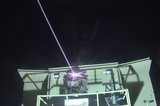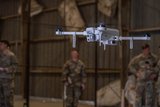General Atomics tests railgun projectile
General Atomics Electromagnetic Systems (GA-EMS) has conducted testing of hypersonic projectiles with prototype components for its Guidance Electronics Unit (GEU) at the US Army Dugway Proving Ground in Utah.
The testing saw the projectiles successfully perform programmed actions and communicate component performance to a ground station via a telemetry link. The GEU, housed in the aerodynamically stable test projectile, consists of a number of components, including integrated navigation sensors and processors for guidance, navigation and control.
Five test projectiles were fired from GA-EMS' 3 mega joule Blitzer electromagnetic railgun system at accelerations greater than 30,000 times that of gravity (>30,000 gees).
The projectiles and the critical components within them experienced, survived and operated in the multi-Tesla magnetic field within the launcher and the overall launch environment. According to the company, all of the GEU components performed as expected during and after the launch event, and through multiple seconds of aero-stable flight.
Nick Bucci, vice president, missile defense and space systems, GA-EMS, said: ‘This latest testing series completes the risk reduction and technology maturation of the individual components of our electromagnetic railgun launched hypersonic projectiles.
‘We continue to fire and test our projectiles in an open range setting, allowing us to collect and analyse a significant amount of performance data under real-world conditions.’
GA-EMS' Blitzer railgun is a test asset designed to advance technology development toward multi-mission railgun weapon systems. Railguns launch projectiles using electromagnetic forces instead of chemical propellants and can deliver muzzle velocities greater than twice those of conventional guns.
More from Defence Notes
-
![NATO experiments with solutions to integrate networks, AI and uncrewed systems]()
NATO experiments with solutions to integrate networks, AI and uncrewed systems
During the latest edition of the NATO DiBaX, the alliance tested multiple capabilities to inform requirements for future efforts.
-
![Leonardo unveils plans for Michelangelo air defence dome]()
Leonardo unveils plans for Michelangelo air defence dome
The new multi-layered defence system will harness AI to neutralise airborne threats and protect Europe from Russian aggression.
-
![What will next-gen counter-UAS capabilities for the US look like?]()
What will next-gen counter-UAS capabilities for the US look like?
Future US counter-uncrewed aerial system solutions are likely to require a flexible, multi-layered approach to tackle a broad spectrum of new threats as they emerge.
-
![Elbit Systems awarded $2.3 billion contract as results soar]()
Elbit Systems awarded $2.3 billion contract as results soar
The company’s order backlog as of 30 September totalled $25.2 billion and more than a third of this is scheduled to be fulfilled before the end of 2026.
-
![US military foresees growing use of 3D printing]()
US military foresees growing use of 3D printing
Advanced manufacturing has evolved to meet military requirements and now supports multiple US critical assets, including Arleigh Burke-class destroyers, F-18, F-22, F-35, Bradley, HMMWV and Patriot.
-
![Irish Naval Service expands as the country looks to defence during EU presidency]()
Irish Naval Service expands as the country looks to defence during EU presidency
The Irish Naval Service has struggled to maintain capability, particularly in the face of lucrative private sector offers luring away personnel.
























